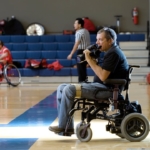Prehabilitation may not improve knee replacement results
Exercises and education prescribed as prehabilitation before total knee replacements (TKR) may not significantly improve the outcomes of the surgery, researchers say.

Communify Queensland
Laird Harrison, Medscape Medical News March 9, 2022
“This randomized clinical trial found no evidence that multidisciplinary prehabilitation before TKR for osteoarthritis improves short-term functional independence or reduces midterm activity limitations after surgery,” write Christelle Nguyen MD PhD, Cochin Hospital, University Center, Paris, and colleagues in JAMA Network Open.
The finding contradicts previous research and the approach followed by many surgeons who assign weeks of regimens to improve their patients’ health before operating on them.
But the limitations of the study make its significance hard to interpret, said Bert Mandelbaum MD, in an interview with Medscape Medical News. Mandelbaum is professor of orthopedics at Cedars-Sinai Kerlan-Jobe Institute in Los Angeles, California, and team physician for the Los Angeles Galaxy professional soccer club, and was not involved in the study.
Previous research has shown that people fare better after total knee replacement if they start out in good health. And a few studies have suggested that physical therapy, exercise therapy, occupational therapy, and education, either alone or in combination, can improve outcomes and shorten hospital stay. But most of these studies have had small sample sizes.
In search of more definitive evidence, Nguyen et al. recruited — from three French tertiary care centers — 178 women and 84 men, with a mean age of 68.6 years, whose osteoarthritis made them candidates for total knee replacement.
The researchers randomly assigned the patients to two groups of 131 each. One group received standard advice at the discretion of their surgeons and an information booklet.
The other group received the same information, advice, and rehabilitation. In addition, they experienced four supervised sessions of education and exercises for 2 weeks starting 2 months before their knee replacement. The sessions consisted of 30 minutes of education and 60 minutes of exercises. In the educational sessions, they learned about the positive effects of exercise therapy, work rehabilitation, social support, weight management, stress and anxiety, and returning home.
The exercise program consisted of muscle strengthening, lower-limb stretching, endurance training, proprioception exercises, walking and balance exercises, training to perform four functional tests (transfer from lying to sitting, transfer from sitting to standing, walking 30 meters, and going up and down a flight of stairs), and a home-based program.
The regimen didn’t seem to make much difference. Tested a mean of four days after the surgery, only 34% of the patients who underwent prehabilitation had achieved functional independence, defined as their ability to perform the four functional tests without help. That was scarcely better than the 27% of the control group who attained that outcome; the difference was not statistically significant (P = .15).
At 6 months, the mean area under the curve of the Western Ontario and McMaster Universities Osteoarthritis Index (WOMAC) function subscale was 38.10 mm2 in the group that underwent the experimental program, versus 40.7 mm2 in the control group, a difference that was also not statistically significant (P = .31).
The researchers found no evidence of reduced pain or activity limitations, improved health-related quality of life, or increased number of steps in the previous week in the experimental group compared with the control group at 6 and 12 months after surgery.
The researchers also found that the mean costs of the two groups were equivalent: €15,573 ($20,516) in the experimental group versus €15 987 ($21,061) in the control group.
One possible explanation for the small difference between the two groups could be low participation: 33% of the patients assigned to the prehabilitation group didn’t participate, perhaps because they had such severe arthritis that they found the regimen burdensome. “Prehabilitation should probably include more targeted modalities than the ones delivered in the current study,” the researchers write. “For example, a preoperative, simplified, home-based rehabilitation education program could represent a more acceptable solution in this population.”
The researchers also noted that the effectiveness of total knee replacement itself could have obscured benefits from the prehabilitation. And they noted that the information booklet and standard advice given to the control group could have improved the outcomes for those patients.
That’s an important consideration, Mandelbaum said. “As far as I can see, there’s no way to determine what the people were doing or not doing in the control group.”
Another limitation to the study is that WOMAC scores don’t measure activity levels above a basic level, Mandelbaum said. If some patients improved their ability to do more demanding activities, such as hiking, this study would not have captured that improvement, he said.
Clinicians should recommend exercise regimens to their patients before surgery, he said. “It’s just common sense.”
| Authors reported relationships with Medacata, Grunenthal, Zimmer, Adler, the French Ministry of Health, and Programme Hospitalier de Recherche Clinique. The study was funded by the French Ministry of Health. Mandelbaum reported no relevant financial relationships. ClinicalTrials.gov Identifier: NCT01671917. |
| Laird Harrison writes about science, health, and culture. His work has appeared in national magazines, in newspapers, on public radio, and on websites. He is at work on a novel about alternate realities in physics. Harrison teaches writing at the Writers Grotto. Visit him at www.lairdharrison.com or follow him on Twitter: @LairdH. |
| For more news, follow Medscape on Facebook, Twitter, YouTube, and LinkedIn. |
![]() Source Medscape Medical News
Source Medscape Medical News
| References |
Effect of Prehabilitation Before Total Knee Replacement for Knee Osteoarthritis on Functional Outcomes: A Randomized Clinical Trial, Nguyen C, Boutron I, Roren A, Anract P, Beaudreuil J, Biau D, Boisgard S, Daste C, Durand-Zaleski I, Eschalier B, Gil C, Lefèvre-Colau MM, Nizard R, Perrodeau É, Rabetrano H, Richette P, Sanchez K, Zalc J, Coudeyre E, Rannou F. JAMA Netw Open. 2022 Mar 1;5(3):e221462. doi: 10.1001/jamanetworkopen.2022.1462. Full text
| Further reading |
Impact of prehabilitation on objectively measured physical activity levels in elective surgery patients: a systematic review, Wagnild JM, Akowuah E, Maier RH, Hancock HC, Kasim A. BMJ Open. 2021 Sep 7;11(9):e049202. doi: 10.1136/bmjopen-2021-049202. Full text
Is it necessary to perform prehabilitation exercise for patients undergoing total knee arthroplasty: meta-analysis of randomized controlled trials, Chen H, Li S, Ruan T, Liu L, Fang L. Phys Sportsmed. 2018 Feb;46(1):36-43. doi: 10.1080/00913847.2018.1403274. Epub 2017 Nov 15. Erratum in: Phys Sportsmed. 2018 Sep;46(3):399-403.
Does preoperative rehabilitation for patients planning to undergo joint replacement surgery improve outcomes? A systematic review and meta-analysis of randomised controlled trials, Wang L, Lee M, Zhang Z, Moodie J, Cheng D, Martin J. BMJ Open. 2016 Feb 2;6(2):e009857. doi: 10.1136/bmjopen-2015-009857. Full text






